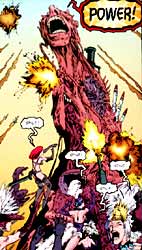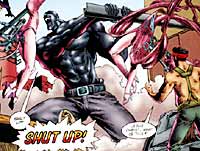At 13 I was alone and afraid. Taught by my well-meaning, progressive, English-teacher parents that violence was wrong, that rage was something to be overcome and cooperation was always better than conflict, I suffocated my deepest fears and desires under a nice-boy persona. Placed in a small, experimental school that was wrong for me, afraid to join my peers in their bumptious rush into adolescent boyhood, I withdrew into passivity and loneliness. My parents, not trusting the violent world of the late 1960s, built a wall between me and the crudest elements of American pop culture.
Then the Incredible Hulk smashed through it.
One of my mother’s students convinced her that Marvel Comics, despite their apparent juvenility and violence, were in fact devoted to lofty messages of pacifism and tolerance. My mother borrowed some, thinking they’d be good for me. And so they were. But not because they preached lofty messages of benevolence. They were good for me because they were juvenile. And violent.
The character who caught me, and freed me, was the Hulk: overgendered and undersocialized, half-naked and half-witted, raging against a frightened world that misunderstood and persecuted him. Suddenly I had a fantasy self to carry my stifled rage and buried desire for power. I had a fantasy self who was a self: unafraid of his desires and the world’s disapproval, unhesitating and effective in action. “Puny boy follow Hulk!” roared my fantasy self, and I followed.
I followed him to new friends — other sensitive geeks chasing their own inner brutes — and I followed him to the arrogant, self-exposing, self-assertive, superheroic decision to become a writer. Eventually, I left him behind, followed more sophisticated heroes, and finally my own lead along a twisting path to a career and an identity. In my 30s, I found myself writing action movies and comic books. I wrote some Hulk stories, and met the geek-geniuses who created him. I saw my own creations turned into action figures, cartoons, and computer games. I talked to the kids who read my stories. Across generations, genders, and ethnicities I kept seeing the same story: people pulling themselves out of emotional traps by immersing themselves in violent stories. People integrating the scariest, most fervently denied fragments of their psyches into fuller senses of selfhood through fantasies of superhuman combat and destruction.
I have watched my son living the same story — transforming himself into a bloodthirsty dinosaur to embolden himself for the plunge into preschool, a Power Ranger to muscle through a social competition in kindergarten. In the first grade, his friends started climbing a tree at school. But he was afraid: of falling, of the centipedes crawling on the trunk, of sharp branches, of his friends’ derision. I took my cue from his own fantasies and read him old Tarzan comics, rich in combat and bright with flashing knives. For two weeks he lived in them. Then he put them aside. And he climbed the tree.

|
But all the while, especially in the wake of the recent burst of school shootings, I heard pop psychologists insisting that violent stories are harmful to kids, heard teachers begging parents to keep their kids away from “junk culture,” heard a guilt-stricken friend with a son who loved Pokémon lament, “I’ve turned into the bad mom who lets her kid eat sugary cereal and watch cartoons!”
That’s when I started the research.
“Fear, greed, power-hunger, rage: these are aspects of our selves that we try not to experience in our lives but often want, even need, to experience vicariously through stories of others,” writes Melanie Moore, Ph.D., a psychologist who works with urban teens. “Children need violent entertainment in order to explore the inescapable feelings that they’ve been taught to deny, and to reintegrate those feelings into a more whole, more complex, more resilient selfhood.”
Moore consults to public schools and local governments, and is also raising a daughter. For the past three years she and I have been studying the ways in which children use violent stories to meet their emotional and developmental needs — and the ways in which adults can help them use those stories healthily. With her help I developed Power Play, a program for helping young people improve their self-knowledge and sense of potency through heroic, combative storytelling.
We’ve found that every aspect of even the trashiest pop-culture story can have its own developmental function. Pretending to have superhuman powers helps children conquer the feelings of powerlessness that inevitably come with being so young and small. The dual-identity concept at the heart of many superhero stories helps kids negotiate the conflicts between the inner self and the public self as they work through the early stages of socialization. Identification with a rebellious, even destructive, hero helps children learn to push back against a modern culture that cultivates fear and teaches dependency.
At its most fundamental level, what we call “creative violence” — head-bonking cartoons, bloody videogames, playground karate, toy guns — gives children a tool to master their rage. Children will feel rage. Even the sweetest and most civilized of them, even those whose parents read the better class of literary magazines, will feel rage. The world is uncontrollable and incomprehensible; mastering it is a terrifying, enraging task. Rage can be an energizing emotion, a shot of courage to push us to resist greater threats, take more control, than we ever thought we could. But rage is also the emotion our culture distrusts the most. Most of us are taught early on to fear our own. Through immersion in imaginary combat and identification with a violent protagonist, children engage the rage they’ve stifled, come to fear it less, and become more capable of utilizing it against life’s challenges.
I knew one little girl who went around exploding with fantasies so violent that other moms would draw her mother aside to whisper, “I think you should know something about Emily….” Her parents were separating, and she was small, an only child, a tomboy at an age when her classmates were dividing sharply along gender lines. On the playground she acted out “Sailor Moon” fights, and in the classroom she wrote stories about people being stabbed with knives. The more adults tried to control her stories, the more she acted out the roles of her angry heroes: breaking rules, testing limits, roaring threats.
Then her mother and I started helping her tell her stories. She wrote them, performed them, drew them like comics: sometimes bloody, sometimes tender, always blending the images of pop culture with her own most private fantasies. She came out of it just as fiery and strong, but more self-controlled and socially competent: a leader among her peers, the one student in her class who could truly pull boys and girls together.

|
I worked with an older girl, a middle-class “nice girl,” who held herself together through a chaotic family situation and a tumultuous adolescence with gangsta rap. In the mythologized street violence of Ice T, the rage and strutting of his music and lyrics, she found a theater of the mind in which she could be powerful, ruthless, invulnerable. She avoided the heavy drug use that sank many of her peers, and flowered in college as a writer and political activist.
I’m not going to argue that violent entertainment is harmless. I think it has helped inspire some people to real-life violence. I am going to argue that it’s helped hundreds of people for every one it’s hurt, and that it can help far more if we learn to use it well. I am going to argue that our fear of “youth violence” isn’t well-founded on reality, and that the fear can do more harm than the reality. We act as though our highest priority is to prevent our children from growing up into murderous thugs — but modern kids are far more likely to grow up too passive, too distrustful of themselves, too easily manipulated.
We send the message to our children in a hundred ways that their craving for imaginary gun battles and symbolic killings is wrong, or at least dangerous. Even when we don’t call for censorship or forbid “Mortal Kombat,” we moan to other parents within our kids’ earshot about the “awful violence” in the entertainment they love. We tell our kids that it isn’t nice to play-fight, or we steer them from some monstrous action figure to a pro-social doll. Even in the most progressive households, where we make such a point of letting children feel what they feel, we rush to substitute an enlightened discussion for the raw material of rageful fantasy. In the process, we risk confusing them about their natural aggression in the same way the Victorians confused their children about their sexuality. When we try to protect our children from their own feelings and fantasies, we shelter them not against violence but against power and selfhood.
Top image: “Tommy & the Monsters”© TM Gerard Jones and Will Jacobs. Art©Arthur Adams.
Other images: “Oktane”© TMGerard Jones & Gene Ha.















